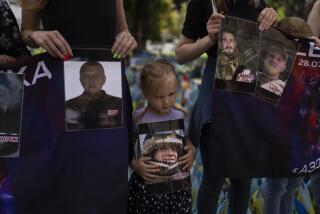Nuclear Plant Crisis Is Over, Soviets Report
- Share via
MOSCOW — A senior Soviet scientist admitted Sunday that the Chernobyl disaster was potentially catastrophic, but he insisted that the danger has now passed in what has been written into history as the world’s worst nuclear accident.
“Theoretically, until today, there existed the possibility of a catastrophe because a large amount of fuel and reactor graphite remained in an overheated condition,” said Yevgeny P. Velikhov, vice president of the Soviet Academy of Sciences and head of the Soviet commission investigating the disaster.
“Now that possibility is no more,” Velikhov added, describing Sunday as a turning point. He said the plant eventually would be put back into operation, once it was safe to do so.
No New Explosion Feared
He said there no longer is any danger of a further explosion or a total meltdown of the reactor as some Western experts had feared, the official Tass news agency reported.
Velikhov made the comments in Kiev, 60 miles south of Chernobyl, as Soviet citizens--and the rest of the world--were given the most detailed look at the disaster site. It appeared on Soviet television screens Sunday as a ghost town.
Last week, state television showed a shorter film of the plant taken from a helicopter.
Soviet leader Mikhail S. Gorbachev continued his silence on Chernobyl, causing Western diplomats to speculate on why he decided to remain mute during the greatest domestic crisis in his 14-month tenure as general secretary of the Communist Party.
But Soviet sources said it is quite normal for a Soviet leader to defer any statement until a crisis is brought under control rather than risk the spread of panic by speaking out earlier.
Western diplomats have said that Gorbachev has lost credibility in Western Europe by not providing more information more promptly about the Chernobyl disaster.
“This is a man who has been showing for the past year how much he is in charge,” said one European envoy. “His silence is beginning to look strange, not just abroad but at home as well.”
For whatever reason, Gorbachev has not uttered a single word about the accident despite his advocacy of greater public openness and apparent readiness to admit shortcomings.
Valentin M. Falin, director of the Novosti press agency, was quoted by the West German magazine Der Spiegel as saying that Gorbachev was informed about the Chernobyl accident on Saturday, April 26, the day that it happened.
But Gorbachev did not learn about the full extent of the disaster until shortly before a special Politburo meeting was held to discuss Chernobyl, Falin was quoted as saying.
The Soviet government made a 22-word announcement of the accident on the evening of April 28, two days after Nordic countries detected a radioactive cloud that came from the blast site.
First Film of ‘Danger Zone’
Soviet TV viewers Sunday saw the first film from inside the closed Chernobyl “danger zone,” a radius of 19 miles from the stricken nuclear plant.
They saw abandoned main streets in a town that had been home to 30,000 people. The broadcast showed traffic police in gas masks and a government task force the announcer said was working a 19-hour day to deal with the consequences of the tragedy.
In addition, wells were shown sealed and houses were closed along the streets of Chernobyl, which was evacuated a week ago as a precaution against radioactive poisoning of its inhabitants.
Despite the eerie silence along the streets of the city, Ivan S. Silayev, a first deputy prime minister, said: “Today we have come to the conclusion that the main danger has been eliminated. . . . No great catastrophe threatens us . . . although this does not mean we can stop our work.”
Silayev told viewers that Sunday was “historic” in that it was the turning point in the operation. “Today we have come to the conclusion that the main danger has been eliminated,” he said.
Most Complete Picture
The film, partly shot from inside a television journalist’s car, gave the most complete picture to date of what is happening inside the evacuated zone and at the headquarters of the Chernobyl disaster relief effort.
Officials, wearing white coats and masks, were shown working in the headquarters building. An announcer said they began at 6 a.m. and often did not finish until 1 a.m. the following morning.
Velikhov said that radioactive substances are being encased in concrete to make sure that radioactivity did not contaminate ground water. But he said there was no doubt that Chernobyl will resume operations.
“At a certain time, dictated by safety considerations, the station will resume work and supply power,” Velikhov said.
Meanwhile, a Ukrainian health official Sunday denied a report that two more Soviet citizens have died as a result of the accident. Der Spiegel on Saturday quoted Falin as saying two people who were hospitalized as a result of the accident have since died, bringing the death toll to four.
Statement ‘Not True’
Kremlin statements have reported only two deaths. An assistant to Ukrainian Health Minister Anatoly Y. Romanenko, reached by telephone by the Associated Press in Kiev, said Falin’s statement “is not true.”
Last week, East European journalists quoted First Deputy Health Minister Yevgeny I. Vorobyev as saying that a victim had died of radiation exposure, bringing the death toll to three. Officials at the Health Ministry in Moscow refused to comment on Vorobyev’s or Falin’s statements. Government statements have said that in addition to the two dead, 204 people were hospitalized and 18 of them were in serious condition.
More to Read
Sign up for Essential California
The most important California stories and recommendations in your inbox every morning.
You may occasionally receive promotional content from the Los Angeles Times.













